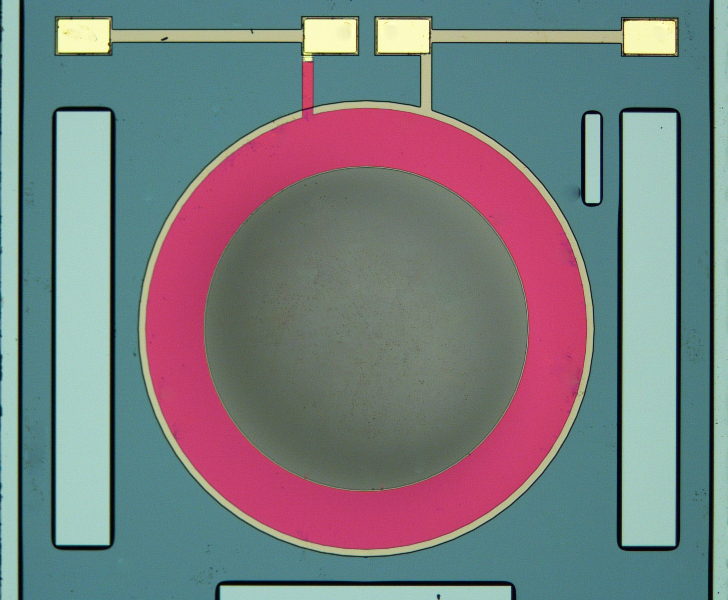
Description

Passenger expectations for a quiet flight experience [1] coupled with concern about long-term noise exposure of flight crews [2] drive aircraft manufacturers to reduce cabin noise in flight. Cabin noise has traditionally been limited using insulating panels and skin dampers on the fuselage. Unfortunately, these thin panels are not effective at reducing low frequency (long wavelength) noise and cannot be made thicker due to weight concerns [1]. Treating the noise at its source shows potential for reduction of low frequency noise and weight savings compared to insulating panels. With fuel costs rapidly increasing, reduction of excess weight and subsequent maximization of the "revenue-generating payload" [3] is more important than ever.
In order to identify noise sources and assess the impact of noise reduction technologies during the design process, aircraft manufacturers require robust, low cost microphones. Measuring primary sources of cabin noise, such as shockcell noise, is difficult under simulated cruise conditions in test facilities [1] and establishes the need for microphones that can be used in full-scale tests at altitude. Their use on the fuselage exterior requires extremely small packaged sizes, in addition to the ability to withstand moisture and freezing conditions at flight altitudes. Microelectromechanical systems (MEMS) microphones show promise for meeting the stringent performance requirements of aircraft manufacturers at reduced size and cost, made possible using batch fabrication technology [4-9].
In this work, models are developed to predict performance of a MEMS piezoelectric microphone, including a laminated piezoelectric composite plate model and a lumped element model to capture dynamic behavior. These models are implemented in an optimization procedure for minimization of minimum detectable pressure (MDP) to yield an optimal design that meets the stringent dynamic range constraints for aeroacoustic applications. The optimal design is fabricated and characterized.

Lumped Element Model (LEM) of the MEMS Piezoelectric Mic

Piezoelectric MEMS Mic Die
References
- V. G. Mengle, U. Ganz, E. J. Bultemeier, and F. T. Calkins, "Clocking effects of chevrons with azimuthally-varying immersions on shockcell/cabin noise," in Proceedings of the 29th AIAA Aeroacoustics Conference, AIAA Paper #08- 3000, Vancouver, British Columbia Canada, 2008, AIAA.
- International Civil Aviation Organization, "Occupational safety and health protections for cabin crew members," in 36th Assembly of the International Civil Avation Organization, A36-WP/208, Montreal, Canada, September 2007.
- V. G. Mengle, U. Ganz, E. Nesbitt, E. J. Bultemeier, and R. Thomas, "Flight test results for uniquely tailored propulsion-airframe aeroacoustic chevrons: Shockcell noise," in Proceedings of the 27th AIAA Aeroacoustics Conference,AIAA Paper #08-3000, Cambridge, MA, 2008, AIAA.
- P. J. King and J. R. Underbrink, "Characterization of a microelectromechanical systems (MEMS) microphone," in 14th AIAA/CEAS Aeroacoustics Conference, Vancouver, British Columbia, Canada, 2008, AIAA.
- M. Sheplak, K. S. Breuer, and M. A. Schmidt, "A wafer-bonded, silicon-nitride membrane microphone with dielectrically-isolated single crystal silicon piezo- resistors," in Proceedings of 1998 Solid-State Sensor and Actuator Workshop, Hilton Head Island, SC, 1998, pp. 23-26.
- M. Sheplak, M. Seiner, K. S. Breuer, and M. A. Schmidt, "A MEMS microphone for aeroacoustic measurements," in Proceedings of 37th AIAA Aerospace Sciences Meeting, AIAA Paper #99-0606, Reno, NV, 1999, AIAA.
- D. P. Arnold, S. Gururaj, S. Bhardwaj, T. Nishida, and M. Sheplak, "A piezoresistive microphone for aeroacoustic measurements," in Proceedings of ASME IMECE 2001, International Mechanical Engineering Congress and Exposition, New York, NY, 2001, pp. 281-288, ASME.
- S. Horowitz, T. Nishida, L. Cattafesta, and M. Sheplak, "Development of a micromachined piezoelectric microphone for aeroacoustics applications," Journal of the Acoustical Society of America, vol. 122, pp. 3428-3436, 2007.
- D. Martin, Design, fabrication, and characterization of a MEMS dual-backplate capacitive microphone, Ph.D. dissertation, University of Florida, Gainesville, FL, 2007.

